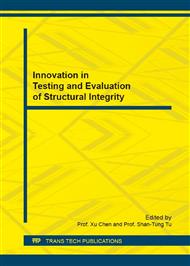[1]
Chen CR, Kolednik O. Comparison of cohesive zone parameters and crack tip stress states between two different specimen types. International Journal of Fracture 132(2005)135-152.
DOI: 10.1007/s10704-005-0626-2
Google Scholar
[2]
Needleman A. A continuum model for void nucleation by inclusion debonding. Journal of Applied Mechanics 54(1987)525-531.
DOI: 10.1115/1.3173064
Google Scholar
[3]
Needleman A. An analysis of decohesion along an imperfect interface. International Journal of Fracture 42(1990)21-40.
DOI: 10.1007/978-94-017-2444-9_2
Google Scholar
[4]
Scheider I, Brocks W. Simulation of cup-cone fracture using the cohesive model. Engineering Fracture Mechanics 70(2003)1943-(1962).
DOI: 10.1016/s0013-7944(03)00133-4
Google Scholar
[5]
Lin G, Cornec A, Schwable KH. Three-dimensional finite element simulation of crack extension in aluminum alloy 2024FC. Fatigue & Fracture of Engineering Materials & Structures 21(1998)1159-1173.
DOI: 10.1046/j.1460-2695.1998.00096.x
Google Scholar
[6]
Yuan H, Lin GY, Cornec A. Application of cohesive zone model for assessment of ductile fracture process. Journal of Engineering Materials and Technology 118(1996)192-200.
DOI: 10.1115/1.2804886
Google Scholar
[7]
Siegmund T, Brocks W. A numerical study on the correlation between the work of separation and the dissipation rate in ductile fracture. Engineering Fracture Mechanics 67(2000)139-154.
DOI: 10.1016/s0013-7944(00)00054-0
Google Scholar
[8]
Li H, Yuan H, Li X. Assessment of low cycle fatigue crack growth under mixed-mode loading conditions by using a cohesive zone model. International Journal of Fatigue 75(2015)39-50.
DOI: 10.1016/j.ijfatigue.2015.01.008
Google Scholar
[9]
Yuan H, Li X. Effects of the cohesive law on ductile crack propagation simulation by using cohesive zone models. Engineering Fracture Mechanics 126(2014)1-11.
DOI: 10.1016/j.engfracmech.2014.04.019
Google Scholar
[10]
Kordisch H, Sommer E, Schmitt W. The influence of triaxiality on stable crack growth. Nuclear Engineering and Design 112(1989)27-35.
DOI: 10.1016/0029-5493(89)90142-8
Google Scholar
[11]
Scheider I, Brocks W. Simulation of cup-cone fracture using the cohesive model. Engineering Fracture Mechanics 70(2003)1943-(1962).
DOI: 10.1016/s0013-7944(03)00133-4
Google Scholar
[12]
Scheider I, Rajendran M, and Banerjee A. Comparison of different stress state dependent cohesive zone models applied to thin walled structures. Engineering Fracture Mechanics 78(2011)534-543.
DOI: 10.1016/j.engfracmech.2010.05.003
Google Scholar


